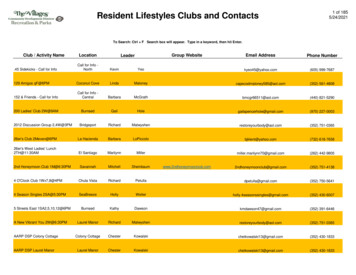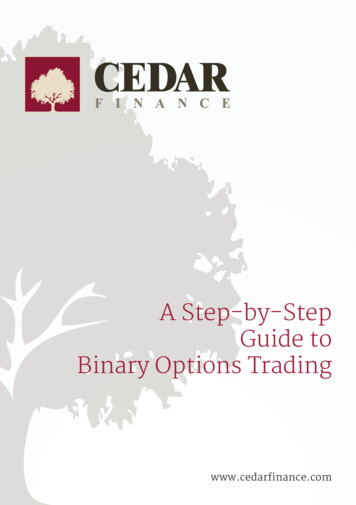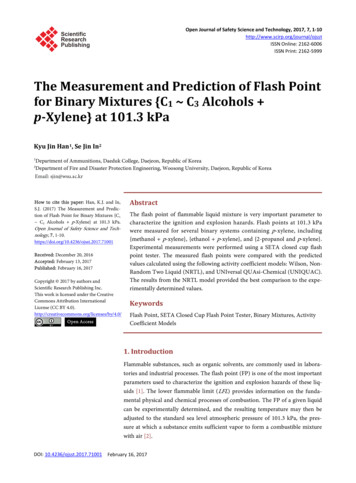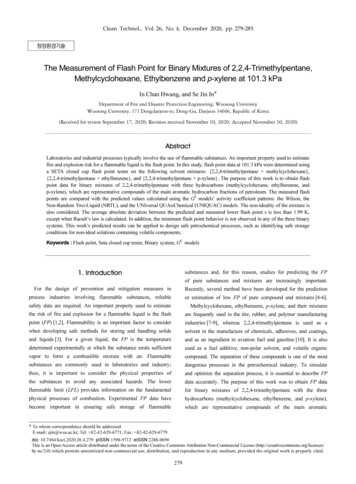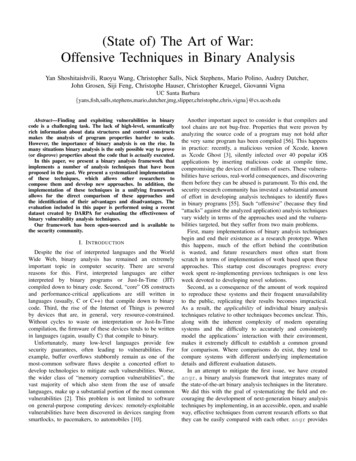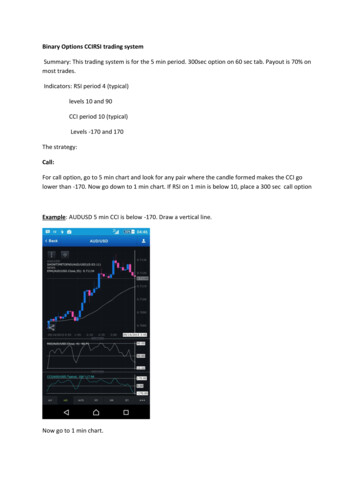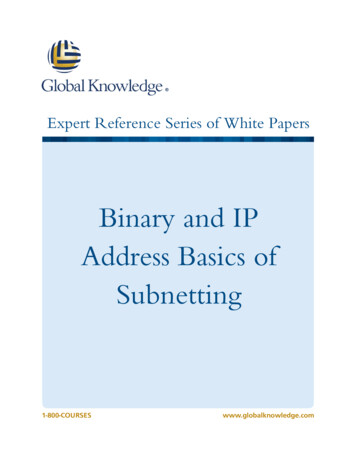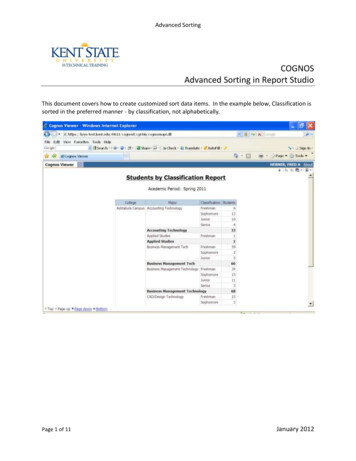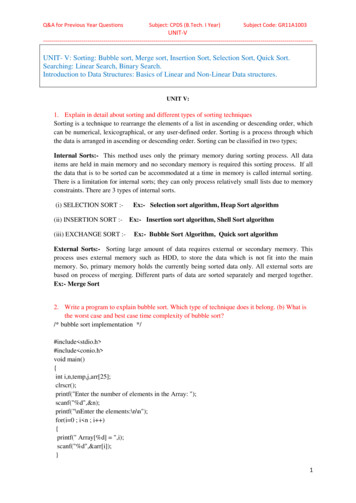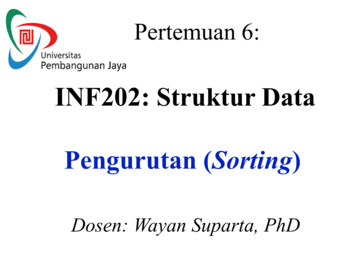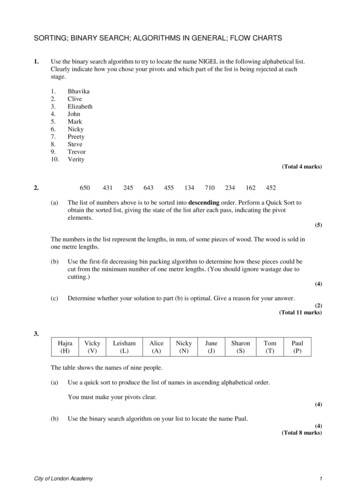
Transcription
SORTING; BINARY SEARCH; ALGORITHMS IN GENERAL; FLOW CHARTS1.Use the binary search algorithm to try to locate the name NIGEL in the following alphabetical list.Clearly indicate how you chose your pivots and which part of the list is being rejected at thJohnMarkNickyPreetySteveTrevorVerity(Total 4 marks)2.650(a)431245643455134710234162452The list of numbers above is to be sorted into descending order. Perform a Quick Sort toobtain the sorted list, giving the state of the list after each pass, indicating the pivotelements.(5)The numbers in the list represent the lengths, in mm, of some pieces of wood. The wood is sold inone metre lengths.(b)Use the first-fit decreasing bin packing algorithm to determine how these pieces could becut from the minimum number of one metre lengths. (You should ignore wastage due tocutting.)(4)(c)Determine whether your solution to part (b) is optimal. Give a reason for your answer.(2)(Total 11 June(J)Sharon(S)Tom(T)Paul(P)The table shows the names of nine people.(a)Use a quick sort to produce the list of names in ascending alphabetical order.You must make your pivots clear.(4)(b)Use the binary search algorithm on your list to locate the name Paul.(4)(Total 8 marks)City of London Academy1
4.41284231363229The numbers in the list represent the weights, in kilograms, of seven statues. They are to betransported in crates that will each hold a maximum weight of 60 kilograms.(a)Calculate a lower bound for the number of crates that will be needed to transport thestatues.(2)(b)Use the first-fit bin packing algorithm to allocate the statues to the crates.(3)(c)Use the full bin algorithm to allocate the statues to the crates.(2)(d)Explain why it is not possible to transport the statues using fewer crates than the numberneeded for part (c).(2)(Total 9 marks)5.A builder is asked to replace the guttering on a house. The lengths needed, in metres, are0.6, 4.0, 2.5, 3.2, 0.5, 2.6, 0.4, 0.3, 4.0 and 1.0Guttering is sold in 4 m lengths.(a)Carry out a quick sort to produce a list of the lengths needed in descending order. Youshould show the result of each pass and identify your pivots clearly.(5)(b)Apply the first-fit decreasing bin-packing algorithm to your ordered list to determine thetotal number of 4 m lengths needed.(4)(c)Does the answer to part (b) use the minimum number of 4 m lengths? You must justify youranswer.(2)(Total 11 marks)City of London Academy2
6.An algorithm is described by the flowchart shown in the diagram above.(a)Given that S 25 000, complete the table in the answer book to show the results obtained ateach step when the algorithm is applied.You may not need to use all the lines in this tableCity of London Academy3
STRR 0?Output(5)This algorithm is designed to model a possible system of income tax, T, on an annual salary, S.(b)Write down the amount of income tax paid by a person with an annual salary of 25 000.(1)(c)Find the maximum annual salary of a person who pays no tax.(1)(Total 7 marks)7.3245172338281691210The numbers in the list above represent the lengths, in metres, of ten lengths of fabric. They are tobe cut from rolls of fabric of length 60m.(a)Calculate a lower bound for the number of rolls needed.(2)(b)Use the first-fit bin packing algorithm to determine how these ten lengths can be cut fromrolls of length 60m.(4)(c)Use full bins to find an optimal solution that uses the minimum number of rolls.(3)(Total 9 marks)City of London Academy4
ylan(a)Use the quick sort algorithm to sort the above list into alphabetical order.(5)(b)Use the binary search algorithm to locate the name Louis.(4)(Total 9 genUse a quick sort to produce a list of these names in ascending alphabetical order. You mustmake your pivots clear.(5)(b)Use the binary search algorithm on your list from part (a) to try to locate the name „Hugo‟.(4)(Total 9 marks)10.295273877447386141The numbers in the list represent the lengths in minutes of nine radio programmes. They are to berecorded onto tapes which each store up to 100 minutes of programmes.(a)Obtain a lower bound for the number of tapes needed to store the nine programmes.(2)(b)Use the first-fit bin packing algorithm to fit the programmes onto the tapes.(3)(c)Use the first-fit decreasing bin packing algorithm to fit the programmes onto the tapes.(3)(Total 8 marks)City of London Academy5
11.StartLet A 0Input x, yIs xeven?NoYesA A yx x-1Nox x 2Is x 0?Yesy 2yOutput AStopAn algorithm is described by the flow chart shown above.(a)Given that x 54 and y 63, complete the table below to show the results obtained at eachstep when the algorithm is applied.You may not need to use all of these rows.It may not be necessary to complete all boxes in each row.City of London Academy6
Axyx even?x 0?(7)(b)State what the algorithm achieves.(2)(Total 9 marks)City of London Academy7
12.Use the binary search algorithm to try to locate the name NIGEL in the following alphabetical list.Clearly indicate how you chose your pivots and which part of the list is being rejected at thJohnMarkNickyPreetySteveTrevorVerity(Total 4 marks)13.52485045644753The list of numbers above is to be sorted into descending order. Perform a bubble sort to obtainthe sorted list, giving the state of the list after each completed pass.(Total 4 marks)City of London Academy8
14.StartLet n 0Let A (1 5) 2, to 3 decimal places.Let B (1 – 2, to 3 decimal places.Let n n 1Let C An, to 3 decimal places.Let D Bn, to 3 decimal places.Let E (C – D) 5, to 1 significant figureOutput ENoIsn 4?YesStopAn algorithm is described by the flow chart shown in the figure above.(a)Complete the table below recording the results of each step as the algorithm is applied.(Notice that values of A, B, C and D are to be given to 3 decimal places, and the values of Eto 1 significant figure.)You may not need to use all the rows in this table.City of London Academy9
ABnCDE(8)(b)Write down the output from the algorithm.(1)(Total 9 ter49Rory37Sophie68The table shows the marks obtained by students in a test. The students are listed in alphabeticalorder. Carry out a quick sort to produce a list of students in descending order of marks. Youshould show the result of each pass and identify your pivots clearly.(Total 5 marks)16.650(a)431245643455134710234162452The list of numbers above is to be sorted into descending order. Perform a Quick Sort toobtain the sorted list, giving the state of the list after each pass, indicating the pivotelements.(5)The numbers in the list represent the lengths, in mm, of some pieces of wood. The wood is sold inone metre lengths.(b)Use the first-fit decreasing bin packing algorithm to determine how these pieces could becut from the minimum number of one metre lengths. (You should ignore wastage due tocutting.)(4)City of London Academy10
(c)Determine whether your solution to part (b) is optimal. Give a reason for your answer.(2)(Total 11 marks)17.45,(a)56,37,79,46,18,90,81,51Using the quick sort algorithm, perform one complete iteration towards sorting thesenumbers into ascending order.(2)(b)Using the bubble sort algorithm, perform one complete pass towards sorting the originallist into descending order.(2)Another list of numbers, in ascending order, is7,(c)23,31,37,41,44,50,62,71,73,94Use the binary search algorithm to locate the number 73 in this list.(4)(Total 8 10.PlymouthA binary search is to be performed on the names in the list above to locate the name Newcastle.(a)Explain why a binary search cannot be performed with the list in its present form.(1)(b)Using an appropriate algorithm, alter the list so that a binary search can be performed. Statethe name of the algorithm you use.(4)(c)Use the binary search algorithm on your new list to locate the name Newcastle.(4)(Total 9 marks)City of London Academy11
19.STARTInput aLet b First number in List PLet c abList P: 2, 3, 5, 7, 11, 13, Is can integer?NOIncrease b tonext integerin List PYESOutput bIsa b?NOLet a cYESENDThe diagram above describes an algorithm in the form of a flow chart, where a is a positiveinteger.List P, which is referred to in the flow chart, comprises the prime numbers 2, 3, 5, 7, 11, 13, 17, .(a)Starting with a 90, implement this algorithm. Show your working in the table below.You may not need to use all the rows in this table.City of London Academy12
abcInteger?OutputLista b?(7)(b)Explain the significance of the output list.(2)(c)Write down the final value of c for any initial value of a.(1)(Total 10 marks)20.Nine pieces of wood are required to build a small cabinet. The lengths, in cm, of the pieces ofwood are listed below.20,20,20,35,40,50,60,70,75Planks, one metre in length, can be purchased at a cost of 3 each.(a)The first fit decreasing algorithm is used to determine how many of these planks are to bepurchased to make this cabinet. Find the total cost and the amount of wood wasted.(5)Planks of wood can also be bought in 1.5 m lengths, at a cost of 4 each. The cabinet can be builtusing a mixture of 1 m and 1.5 m planks.(b)Find the minimum cost of making this cabinet. Justify your answer.(4)(Total 9 marks)21.The following list gives the names of some students who have represented Britain in theInternational Mathematics Olympiad.Roper (R), Palmer (P), Boase (B), Young (Y), Thomas (T), Kenney (K), Morris (M),Halliwell (H), Wicker (W), Garesalingam (G).(a)Use the quick sort algorithm to sort the names above into alphabetical order.City of London Academy13
(5)(b)Use the binary search algorithm to locate the name Kenney.(4)(Total 9 marks)22.2522301829212721The list of numbers above is to be sorted into descending order.(a)(i)Perform the first pass of a bubble sort, giving the state of the list after each exchange.(ii)Perform further passes, giving the state of the list after each pass, until thealgorithm terminates.(5)The numbers represent the lengths, in cm, of pieces to be cut from rods of length 50 cm.(b)(i)Show the result of applying the first fit decreasing bin packing algorithm to thissituation.(ii)Determine whether your solution to (b) (i) has used the minimum number of 50 cmrods.(4)(Total 9 marks)23.This question should be answered on the page below.StartA 1A A 160B AIs B aninteger?NoYesPrint AIs A 60?NoYesEndCity of London Academy14
Implement the algorithm given by the flow chart above and state what the algorithm actuallyproduces.(Total 5 marks)Sheet for use in answering this questionIs B 60an 52627282930Yes or 4555657585960Yes or NoWhat the algorithm produces: City of London Academy15
MARK SCHEME1. 1 10 2 6 Nicky M1reject top of list 7 10 2 9 Trevor A1reject bottom of list 7 8 2 8 Steve A1reject bottom of list[7] 7 PreetyA14rejectNigel not in 2234162134A1 ft710650643455431452245234162134A1 ft710650643455452431245234162134A15(b)(c)Bin 1 710 245Bin 3 643 162 134Bin 2 650 234Bin 4 455 452Bin 5 431M1A1A1A1(ft)44116 4.116 5 bins needed TP(A, T)A1AHLJNSPTV(L, P)A1 ftAHJLNPSTV(J)AHJLNPSTVCity of London AcademyA1 cso416
Note1M1: quick sort, pivots, p, chosen and two sublists one p one p.1A1: first pass correct and next pivots chosen correctly/consistently.2A1ft: second pass correct, next pivots correctly/consistently chosen.3A1: all correct, cso.(b) 1 9 5 Nicky, reject 1 – 51st choice 2 M1 A1 6 9 7.5 8 Tom, reject 8 – 92nd choice 2 A1 6 7 6.5 7 Sharon, reject 73rd choice 2 4th choice 6 Paul name foundA1 cso4Note1M1: binary search on what they think is a alphabetical list, choosingpivot, rejecting half list.1A1: first pass correct, condone „sticky‟ pivot here, bod generous2A1: second pass correct, pivot rejected.3A1: cso.Note: If incorrect list in (a) mark (b) as a misread.Alternative solutionsMiddle rightH VLANJSTP(N)M1HLAJNVSTP(A T)A1AHLJNSPTV(L P)A1ftAHJLNPSTV(J)AHJLNPSTVA1csolist sortedMiddle leftH VLANJSTP(N)M1HLAJNVSTP(L S)A1HAJLNPSVT(A V)A1ftAHJLNPSTV(H)AHJLNPSTVCity of London AcademyA1cso17
STPV(N)AHJLNSTPV(S)AHJLNPSTVA1ftA1cso[8]4.(a)e.g. total weight is 239, lower bound is239 3.98 so 4 bins.60M1 A12Note1M1: Any correct statement, must involve calculation1A1: cao (accept 4 for both marks)(b)Bin 1 : 41Bin 2 : 28 31Bin 3 : 42Bin 4 : 36Bin 5 : 32Bin 6 : 29M1 A1A13Note1M1: Bins 1 and 2 correct and at least 6 values put in bins1A1: Bins 1, 2, 3 and 4 correct.2A1: All correctMisread in (b) First Fit DecreasingBin 1: 42 Bin 2: 41 Bin 3: 36 Bin 4: 32 28Bin 5: 31 29(Remove up to two A marks if earned – so M1 max in (b) if first 4bins correct.)(c)Full Bins : 28 32 31 29The other 3 items (42, 41, 36) require 3 separate binsM1 A12Note1M1: Attempt to find two full bins and allocate at least 6 values1A1: cao(d)There are 5 items over 30. No two of these 5 can be pairedin a bin, so at least 5 bins will be required.B2, 1, 02Note1B1: Correct argument may be imprecise or muddled (bod gets B1)City of London Academy18
2B1: A good, clear, correct argument. (They have answeredthe question 41.00.50.50.54.0
(b) Using the bubble sort algorithm, perform one complete pass towards sorting the original list into descending order. (2) Another list of numbers, in ascending order, is 7, 23, 31, 37, 41, 44, 50, 62, 71, 73, 94 (c) Use the binary search algorithm to locate the number 73 in this list. (4) (Total 8 marks) 18. 1. Glasgow 2. Newcastle 3. Manchester
